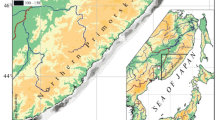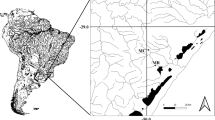Abstract
Aspects of activity pattern, mating, breeding behaviour and reproductive organs were studied in Sesarma intermedia (de Hann) along the Tatara river estuary, Hakata Bay, western Japan. Activity started from early May after a six-month hibernation period. The daily activity pattern was bimodal with one peak after sunset and another before sunrise. Mating started after emerging from hibernation and was ended by July. Practically no mating was seen in August and thereafter, by which time most of the females were carrying eggs. Larger males mated more frequently with any sized adult female. Copulation seemed to take place both in the burrow and on the surface of natural shelter. Females began to carry eggs from mid June on the estuarine habitat, whereas on the coastal habitat ovigerous females could be seen from mid-May. Multiple ovipositions of eggs were realized. Females were able to oviposit three times without any repeated mating. It took about 30 d to incubate one egg mass and less than one week to spawn again. The release of larvae was not sporadic but rather took place within a limited time interval. Sunset seemed to have a great influence on larvae release along the seashore. Energy allocation for reproductive purposes seemed to start before crabs awoke from the hibernation period. Towards the end of the breeding period there was a drastic decline in ovarian development with a remarkable gain in hepatopancreas, a reservoir for energy.
Similar content being viewed by others
Literature cited
Bovbjerg, R. W.: Behavioural ecology of the crab, Pachygrapsus crassipes. Ecology 41, 668–672 (1960)
Cheung, T. S.: Transmolt retention of sperm in adult female carb Menippe mercenaria (Say). Crustaceana 15, 117–120 (1968)
Christy, J. H.: Adaptive significance of semilunar cycles of larval release in fiddler crabs (Uca). Biol. Bull. mar. biol. Lab., Woods Hole, 163, 251–263 (1982)
DeCoursey, P.: Cyclic reproduction of fiddler crabs, Uca. A model for estuarine adaptation. Estuarine 4, 263 (1981)
Forward, R. B., Jr., K. Lohmann and T. W. Cronin: Rhythms in larval release by an estuarine crab Rhithropanopeus harrisii. Biol. Bull. mar. biol. Lab., Woods Hole 163, 287–300 (1982)
Giese, A. C.: Annual reproductive cycles of marine invertebrates. Ann. Rev. Physiol. 21, 247–276 (1959)
Hartnoll, R. G.: Mating in the Brachyura. Crustaceana 16, 161–181 (1969)
Hiatt, R. W.: The Biology of the lined shore crab, Pachygrapsus crassipes Randall. Pacif. Sci. 2, 135–213 (1948)
Izawa, M.: Grouping patterns of feral cats (Felis catus) living on a small island in Japan. Jap. J. Ecol. 32, 373–382 (1978)
Johnston, M. A., P. S. Davies and H. Y. Elder. Possible function of crustacean blood cells. Nature, Lond. 230, 471–472 (1971)
Levinton, J. S.: Marine Ecology. Engelwood Cliffs: Prentice Hall Inc. 1982
Morgan, S. G., J. W. Goy and J. D. Cotlow, Jr.: Multiple ovipositions from single matings in the mud crab Rhithropanopeus harrisii. J. Crustacean Biol. 3, 542–547 (1983)
Nakasone, Y., Y. Ono and S. Goshima: Daily activity and food consumption of the Sesarmid crab Chasmagnathus convexus (Decapoda, Brachyura). Bull. Coll. Educ., Univ. Ryukyus, 26, 37–53 (1982)
Ono, Y.: On the ecological distribution of ocypoid crabs in the estuary. Mem. Fac. Sci., Kyushu Univ. Ser. E.(B) 4, 1–60 (1965)
Pillay, K. K. and Y. Ono: The breeding cycles of two species of Grapsid crabs (Decapoda). Mar. Biol. 45, 237–248 (1978)
Saigusa, M. and Y. Hidaka. Semilunar rhythms in zoea release activity of the land crabs Sesarma. Oecologia 37, 163–176 (1978)
Seiple, W. and M. Salmon: Comparative social behaviour of two Grapsid crabs S. reticulatum (Say) and Cinereum (Bosc). J. exp. mar. Biol. Ecol. 62, 1–24 (1982)
van Hagen, H. O.: Anpassungen an das spezielle Gezeitenzonen-Niveau bei Ocypodiden (Decapoda, Brachyura). Forma Functio 2, 361–413 (1970)
Warner, G. F.: The biology of crabs. London: Elek Science 1977
Young, R. J.: Spawning season of the Californian mussel, Mytilus californianus. Ecology 23, 490–491 (1942)
Author information
Authors and Affiliations
Additional information
Communicated by M. Anraku, Hiroshima
Rights and permissions
About this article
Cite this article
Kyomo, J. Reproductive activities in the sesarmid crab Sesarma intermedia in the coastal and estuarine habitats of Hakata, Japan. Mar. Biol. 91, 319–329 (1986). https://doi.org/10.1007/BF00428625
Accepted:
Issue Date:
DOI: https://doi.org/10.1007/BF00428625




